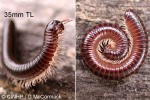Cook Islands Biodiversity Database
Species Page
Trigoniulus corallinus
Veri TinitoPurple Millipede
Multimedia & Additional Resources
| Type | Description | Download |
| Millipede (Rarotonga) | 54KB | |
| Trigoniulus corallinus vs Leptogoniulus sorornus | 63KB |
General Information
Cook Islands Distribution
| Southern Group: Present Makatea: | ||||||||
RR |
MG |
AT |
MK |
MT |
AK |
PL |
TK |
MN |
++++ |
||||||||
| Northern Group: | |||||
TN |
MH |
RK |
PK |
NS |
SW |
++ |
|||||
Scientific Taxonomy
Trigoniulus corallinus (Gervais)
SYNONYMS: Trigoniulus lumbricinus
TAXONOMY: ANIMALIA; ARTHROPODA; ATELOCERATA; DIPLOPODA; Chilognatha; Spirobolida; PACHYBOLIDAE
More Information
SIGNIFICANCE NOTES -
NEGATIVE SIGNIFICANCE: Poisonous secretions - serious. Comments: During prolonged contact noxious secretions can cause skin discoloration and blistering. Healing is slow.
GENERAL NOTE: For defense millipedes secrete noxious chemicals from pores along the sides of their bodies. The chemicals include: hydrocyanic acid (in Polydesmids), alkaloids (in Glomeris) or benzoquinones (in Iules). For humans, these chemicals can cause skin irritation, blistering, brown staining and pain. The effects are slow to heal.
Vouchers & References
Vouchers:
Rarotonga: photo GM, tentative ID R.Shelley 6/2002. Pukapuka: specimen+photo, 2/2004, G.McCormack with ID as QQTrigoniulus corallinus, to BPBM.
References:
None recorded.
Data Update History (information):
zTX, zB02, zM02, zD02
Web Resources
Citation Information
McCormack, Gerald (2007) Cook Islands Biodiversity Database, Version 2007.2. Cook Islands Natural Heritage Trust, Rarotonga. Online at http://cookislands.bishopmuseum.org. ![]()
Please refer to our use policy.

